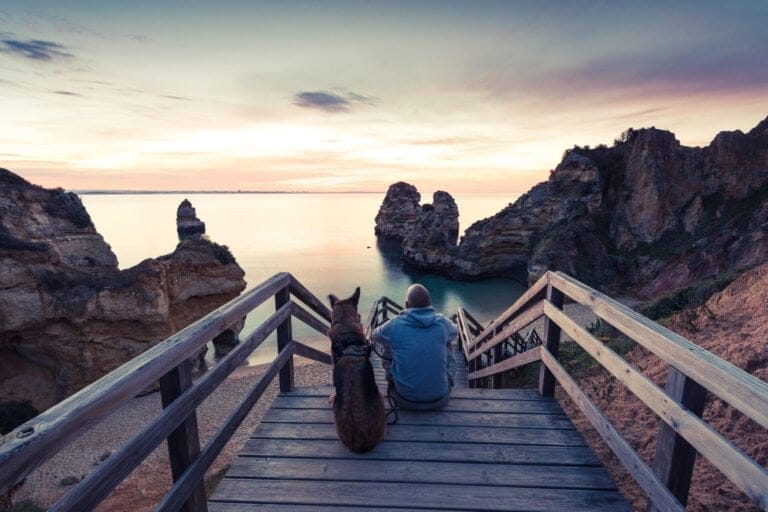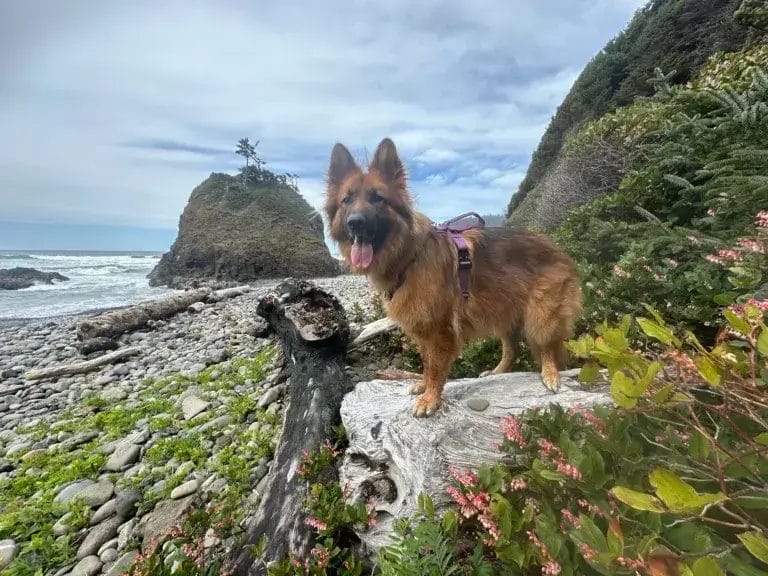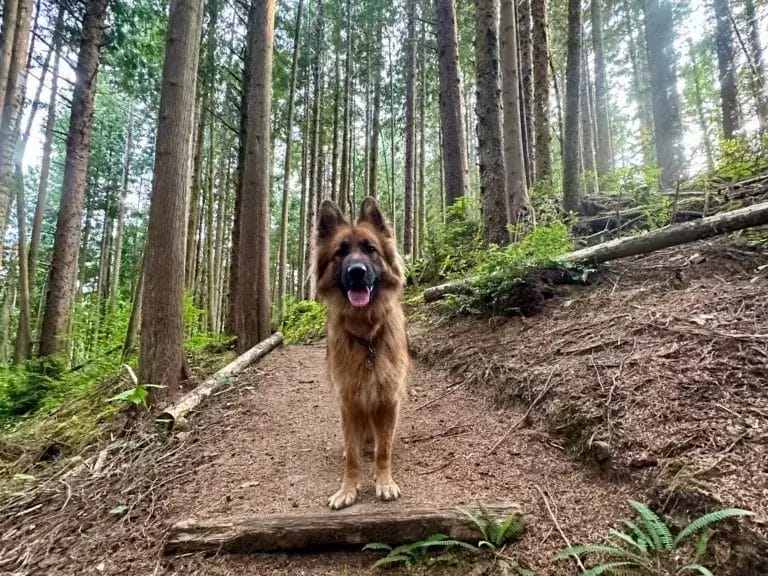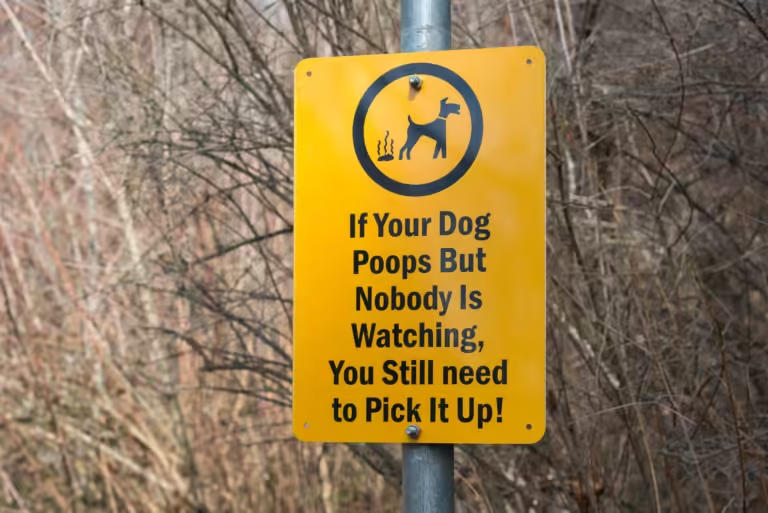Camping With a Dog in Hot Weather: Ultimate Safety & Comfort Guide
I’ll never forget the first summer I took my dog camping. He started panting heavily and refused to leave the shade of our tent. That day opened my eyes to how tough camping with a dog in hot weather can get, and just how unprepared I was for the curveballs summer can throw at our four-legged friends.
While we can splash water on our faces or run for the nearest air conditioning, our dogs count on us to keep them safe and comfortable when the heat cranks up.

Successful hot weather camping with your dog means knowing that temps above 85°F can get dangerous fast. You’ve got to take steps to provide shade, cooling gear, and fresh water at all times.
The difference between a magical outdoor adventure and a panicked trip to the vet often comes down to the little things you do before you leave and how closely you pay attention once you’re out there.
From picking a shady campsite to packing cooling vests and portable water bowls, there are so many ways to keep your hiking buddy happy and healthy in the summer. Over the years, I’ve learned (sometimes the hard way) that camping with dogs in hot weather is a different game than those cool spring or fall trips.
The extra planning is worth it when you see your dog splashing in a creek or snoring under a tarp, totally content.
Key Takeaways
- Keep an eye on temperatures and skip camping if it’s over 85°F, especially with high humidity or blazing sun.
- Bring essential cooling gear like portable shade, cooling vests, extra water, and collapsible bowls.
- Pick campsites with natural shade and water nearby, and watch for early signs of overheating like heavy panting or sluggishness.
Understanding the Challenges of Camping With a Dog in Hot Weather
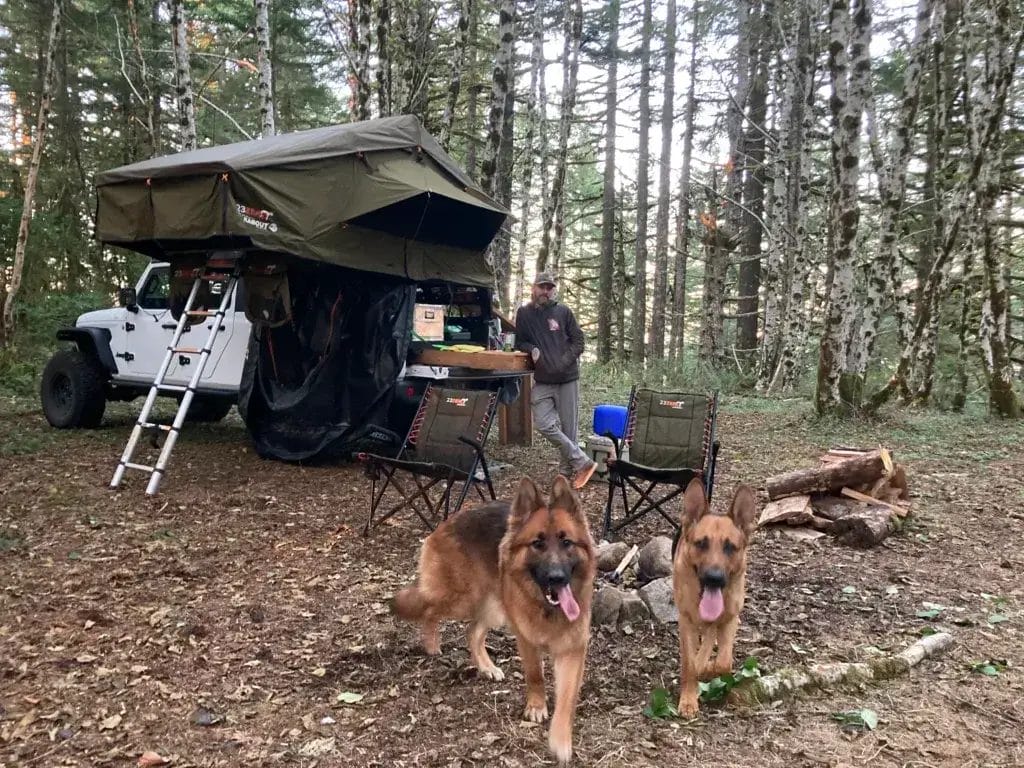
Dogs run into some unique challenges in the heat, and things can go south before you know it. Heat tolerance varies by breed, age, and health, so it’s important to know how your specific dog handles rising temps.
How Dogs Respond to Heat
I learned this lesson on my first summer camping trip with Jack. Unlike us, dogs heat up quickly and can only sweat through their paws.
Panting is their main way to cool off. After a hike, Jack’s tongue hangs out, and he pants like he’s just run a marathon; he’s working hard to shed that heat.
This works alright in mild weather, but once it’s over 80°F, panting just doesn’t cut it. Dogs with thick fur or smushed faces (like pugs or bulldogs) have an even harder time.
Breed differences are huge. My friend’s bulldog overheats in minutes on a hot day, while my neighbor’s husky seems fine until it’s nearly 100°F.
Puppies and older dogs struggle more, too. Their bodies just can’t regulate temperature as well as healthy adults.
Risks of Heatstroke and Dehydration
The scariest camping moment I’ve had was when Jack showed signs of heat exhaustion. A dog’s normal rectal temperature is about 38.3-38.7°C. (equivalent to 100.94-101.66°F) When it creeps up, trouble can start really fast.
Heat exhaustion hits when body temp reaches 39-41°C. (approximately 102.2-105.8°F. ) Your dog might seem wiped out and pant a ton. It’s serious, but you can usually fix it if you act quickly.
Heatstroke is what happens above 41°C – and that’s a full-blown emergency. We’re talking organ damage, even death, if you don’t act fast.
Dehydration often tags along with overheating. Dogs need a steady supply of fresh water, especially if you’re hiking. I’ve seen dogs get dehydrated after just half an hour on a hot trail.
High-risk situations include:
- Pavement or sand that’s too hot for paws
- Direct sun without any shade
- Hard exercise when it’s over 75°F
- Not enough water breaks
Recognizing Signs of Overheating
Spotting warning signs early saved Jack from serious harm. Look for things like heavy panting, sunken eyes, or dry gums.
Early warning signs:
- Panting that doesn’t let up
- Drooling more than usual
- Lethargy or just not wanting to move
- Always trying to find shade
Emergency symptoms:
- Vomiting or diarrhea
- Stumbling or acting confused
- Gums that look bright red or pale
- Glassy, unfocused eyes
I always carry a rectal thermometer when camping with Jack in the summer. If his temp hits 39°C (102.2°F), I start cooling him down right away. Over 41°C (105.8°F)? That’s a straight trip to the vet, no hesitation.
The “five-second rule” is my go-to for checking ground temp. If I can’t hold my hand on the pavement for five seconds, it’s too hot for Jack’s paws.
If your dog seems off, don’t wait. Take action. I’d rather look like an overprotective dog parent than risk losing my best buddy to something preventable.
Essential Preparations for a Safe Hot Weather Trip

Getting your dog ready for hot weather camping takes more than just tossing an extra water bottle in your bag. I’ve found that health checks, basic training, and solid ID can turn a stressful trip into a smooth one.
Vet Visits and Health Checks
I always book a vet visit at least two weeks before we head out, especially if it’s going to be hot. The vet checks Jack’s heart, lungs, and overall fitness. Heat puts extra pressure on their bodies.
Here’s what I always double-check:
- Vaccinations are current
- Flea and tick meds are up to date
- Heartworm prevention is covered
- Any meds that might make heat harder to handle
I ask about breed-specific risks, too. Flat-faced breeds need extra cooling, and thick-coated dogs can surprise you with how fast they get hot. My vet once found a heart murmur in Jack that could’ve made hot weather camping super risky.
We also put together a first aid plan. I keep a list of emergency contacts and the nearest 24-hour animal hospitals along our route. This prep has saved me precious time twice now, in real emergencies.
Training and Socialization
Obedience is non-negotiable when camping in the heat. I need Jack to listen fast if there’s danger. We practice “stay” and “come” in the backyard, especially during the hottest part of the day.
Commands that save the day:
- Stay—keeps your dog in the shade
- Come—gets them off hot surfaces
- Leave it—stops them from drinking sketchy water
- Settle—helps them chill during peak heat
I get Jack used to cooling gear like booties and vests before we ever leave home. The first time I tried booties at camp, Jack acted like he’d lost all four legs. Lesson learned – practice first.
Socializing with other campers and dogs keeps stress down, which helps with overheating. We hit up busy parks for practice, and it makes the real camping trip so much more relaxed for both of us.
Dog Identification and Tags
I never trust just one form of ID when we camp in hot weather. Overheated or scared dogs can bolt, so I stack the odds in my favor.
Here’s my system:
- Collar with my phone number and campground info
- Microchip with updated contact info
- Temporary tag with our campsite number
- Recent photo of Max on my phone
I update Jack’s microchip info before every trip and keep the paperwork handy. Once, my friend’s dog slipped out of his collar while panting hard, but the microchip got him home within hours.
I also write my cell number on Jack’s cooling vest with a Sharpie. It looks goofy, but other campers have used it to get lost dogs back to their people. And I always let someone at home know exactly where we’re camping, just in case we both need help.
Evaporative Cooling for Hot Weather, Compatible with Most Harnesses
Packing Smart: Must-Have Gear for Hot Weather Dog Camping
The first time I took Jack camping in 90-degree weather, I realized regular gear just doesn’t cut it. Smart packing means focusing on cooling solutions, easy access to water, and solid shade options.
Cooling Beds and Mats
Elevated dog beds with canopies are a total game-changer for hot weather camping. The raised design keeps your pup off the sizzling ground and lets air flow underneath.
I love pressure-activated cooling mats that don’t need refrigeration. When your dog lies down, they get instant relief, no batteries, no fuss.
I always bring a lightweight tarp for extra shade around Jack’s bed. It doubles the cooling effect and gives him choices for the perfect nap spot.
Pro tip: Test any new cooling bed at home first. Some dogs need a little time to get used to the feel of new materials, and it’s way easier to work out the kinks in your living room than in the wild.
Self-Cooling, Pressure Activated Mat for Dogs & Cats from 46-80 lbs - Non-Toxic Gel, No Water Needed
Portable Water Bowls and Hydration Solutions
I never head out for dog camping trips without collapsible water bowls. They’re total lifesavers and barely take up any space. I always pack at least two – one for water, one for food.
My go-to kit looks something like this:
- Collapsible silicone bowls with carabiner clips
- Extra water containers (bring twice what you think you’ll need)
- Electrolyte additives for dogs
On hot days, I offer water every 30 minutes, even if my dog acts uninterested. Dogs can be sneaky about thirst; they don’t always let you know until they’re already parched.
For active days, I grab a hands-free water bottle that comes with a little attached bowl. That way, I can hydrate my pup instantly during hikes without digging through my pack.
Sun Protection and Shade Supplies
Shade is non-negotiable when you’re camping with dogs in hot weather. I always bring a lightweight pop-up canopy as my main shade source. It sets up fast and gives us both a break from the heat.
For direct sun, I use dog-safe sunscreen on exposed spots like noses and ear tips. Light-colored pups especially need this little extra layer.
My shade toolkit usually includes:
- Reflective emergency blankets for ground cooling
- Mesh tarps for airflow with sun protection
- Clip-on umbrellas for quick, portable shade
I’ve noticed that setting up shade to catch cross-breezes really cools things down. Even a few degrees can make a huge difference for your dog.
Remember: Aim to keep shade temps below 85°F for most dogs. Veterinary experts who specialize in hot weather camping safety recommend this as a rule of thumb.
For 3/4-5/6-7/8-10 Person, Lightweight & Easy Setup, Portable
Choosing the Right Campsite and Setting Up for Comfort

The right campsite can make or break your hot-weather adventure with your furry sidekick. I’ve learned that natural shade, good airflow, and a smart setup are everything when temps start to climb.
Finding and Creating Shade
Shade is a must when camping with dogs in the heat. My German Shepherd, Jack, gave me a crash course in this during our first summer trip to Joshua Tree.
Natural shade is always the first thing I look for. Seek out campsites near big trees, rocks, or cliffs that block the sun during the hottest hours. I like to scout between 11 AM and 3 PM to see where shadows fall.
If natural shade is lacking, I build my own. A large tarp between trees or poles can work wonders. I usually go for a 10×12-foot tarp that covers both our tent and a chill zone for Jack..
Portable canopies are a game-changer for open spots. I caved and bought an easy-up shelter after watching Jack pant in the sun, worth every penny for that instant relief.
Don’t overlook reflective emergency blankets. I attach them to the sunny side of our setup to bounce the heat away. They’re light and surprisingly effective at cooling down the ground.
Safe Tent Setup for Dogs
Tent placement really affects your dog’s comfort. I’ve made some rookie mistakes that turned our tent into a sauna, so learn from me.
Ventilation is key. I set up our tent to catch cross-breezes and keep both doors open during the day. My current tent’s mesh panels get a real workout in the summer.
I avoid pitching on hot surfaces after Jack burned his paws on sun-baked sand. Grass, pine needles, or any shaded ground is way better. If you have to use hot ground, lay down blankets or sleeping pads as a barrier.
Inside the tent, Jack gets a cooling mat. Those gel-filled mats stay cool without any power and bring instant relief. I also keep a damp towel handy for quick cool-downs.
If you have power, bring a portable fan. Battery fans work for a bit and can help with airflow during the hottest hours.
| Setup Priority | Why It Matters | My Go-To Solution |
|---|---|---|
| Airflow | Prevents overheating | Cross-ventilation positioning |
| Ground temperature | Protects paw pads | Shaded, soft surfaces |
| Emergency cooling | Quick heat relief | Wet towels and cooling mats |
Dog-Friendly Destinations to Beat the Heat
Some places just make hot weather camping easier with dogs. I’ve found that picking the right spot solves most heat problems before they even start.
Higher elevation campgrounds are my favorite for natural cooling. Every 1,000 feet up drops the temperature by 3-5 degrees. I love mountain camping in summer because the nights stay cool, even if the days get toasty.
Lakeside and riverside sites are fantastic. The water cools the air, gives your dog a place to splash, and means you always have fresh water nearby. I always check for dog-friendly campgrounds with swimming access.
Forest campgrounds with thick trees feel like nature’s A/C. The canopy blocks the sun and holds in cool air. Pine forests, in particular, have kept us comfortable through some brutal heat waves.
Look for campgrounds with dog amenities like washing stations or fenced areas. Some even have dog beaches; those features make hot weather management so much easier.
I’d steer clear of desert camping in peak summer unless you really know what you’re doing. The lack of shade and extreme temperatures can be dangerous for dogs, no matter how well you plan.
Keeping Your Dog Cool and Happy Throughout Your Adventure
Hydration, smart timing, and water play are the foundation of happy summer camping with your dog. Mixing paw protection with some fun cooling games keeps my furry buddy comfortable and entertained, even on the hottest days.
Hydration and Paw Care Tips
I always bring twice as much water as I think my dog will need. My first summer camping trip taught me this the hard way – my German Shepherd started panting hard by noon, and we had to ration until evening.
Water Guidelines:
- Small dogs: 1-2 cups per day in mild weather, double that when it’s hot
- Medium dogs: 2-4 cups per day, up to 8 cups in serious heat
- Large dogs: 4-8 cups per day, sometimes 12+ cups when it’s really scorching
I check my dog’s paws every few hours while camping. Hot sand, rocks, and asphalt can burn their pads fast. The five-second rule is simple – if I can’t keep my hand on the ground for five seconds, it’s too hot for my dog’s paws.
Portable water bowls are a must. I like collapsible silicone ones that clip right to my pack. Proper hydration prevents heatstroke and keeps energy up during all our adventures.
Fun Cooling Activities and Water Play
Water activities changed the game for me when camping with dogs. Even a small tub of water can turn into hours of cooling fun.
Some of my favorite cooling games:
- Splash pads: A small kiddie pool or just a natural water source
- Frozen treats: Freeze peanut butter in ice cube trays before the trip
- Wet towel games: Soak towels in cool water for your dog to lounge on
DIY Cooling Station Setup:
- Pick a shaded spot near water
- Lay out wet towels or a cooling mat
- Set water bowls at different heights
- Make a shallow splash area with a tarp or small pool
I’ve seen that water play helps regulate my dog’s temperature naturally. Swimming is the best, but even wading in a shallow creek does wonders.
Timing Walks and Activities Wisely
Early mornings have become my secret weapon for summer camping with my dog. I set my alarm for 5:30 AM to catch those cool, quiet hours before the sun gets serious.
My Daily Schedule:
- 5:30-7:30 AM: Long hikes and playtime
- 8:00 AM-4:00 PM: Rest in shade, quiet games
- 5:00-7:00 PM: Short walks and exploring
- After sunset: Evening adventures
I use the pavement test all the time. If it’s too hot for my bare feet, we stay put. During midday heat, I focus on mental games like puzzle toys, training, and gentle brushing.
Knowing when it’s too hot helps me plan our day. My dog’s excitement doesn’t always match the weather, so sometimes I’ve got to be the responsible one and say, “Not right now, buddy.”
Safety Measures and Emergency Preparedness
Camping with your dog means thinking ahead about wildlife, heat risks, and social situations that could get tricky. I’ve learned that a little preparation for these moments can turn a stressful situation into just another story for the campfire.
Handling Wildlife and Camp Dangers
I always keep my dog on a leash during our camping trips. Wild animals like bears, coyotes, and snakes can be a real headache for curious pups.
My German Shepherd once tried to chase a raccoon into the woods. That moment convinced me to stash all food in bear-proof containers, no matter how short our stay.
Dogs attract wildlife with their scent and barking. It’s wild how quickly things can go sideways if you’re not prepared.
Essential Wildlife Safety Steps:
- Store dog food with human food in sealed containers
- Never let your dog drink from stagnant water sources
- Keep dogs close during dawn and dusk when predators are active
- Carry a whistle and flashlight for emergencies
Teaching the “leave it” command before camping is a lifesaver. Practice this at home until your dog listens every time – trust me, it’s worth it.
I always walk the campsite perimeter first. Broken glass, sharp rocks, and poisonous plants can hide in plain sight.
Some campsites have fire ant hills that can wreck your dog’s paws. A quick walkaround saves a lot of trouble later.
Dealing with Heat Emergencies
Heatstroke in dogs can sneak up on you. My Shepherd started panting heavily on a 90-degree day, and it scared the heck out of me.
Warning Signs I Watch For:
- Heavy panting that doesn’t stop
- Bright red gums and tongue
- Weakness or stumbling
- Vomiting or excessive drooling
When I spot these signs, I move my dog to shade right away. I pour cool water on their belly and paw pads – never ice-cold, just cool from the tap.
I always pack a rectal thermometer for camping. Dog temperatures above 104°F mean heatstroke and you’ll need a vet fast.
My emergency kit has electrolyte powder for dogs and the nearest veterinary clinic’s number. Before every trip, I look up emergency vets along our route – better safe than sorry.
I offer water every 15 minutes during hot weather. We skip hikes during the hottest hours, no matter how tempting the trail looks.
Promote Dog Hydration, Increase Stamina, and Boost Recovery | Electrolyte Water Additive or Food Topper to Prevent Dehydration with Beef Flavoring
Maintaining Good Behavior Around Others
Dog camping means sharing space with other families. I’ve seen aggressive dogs ruin entire weekends for everyone nearby.
My dog stays leashed in all common areas. Even the friendliest dog can scare kids or bother campers who aren’t used to animals.
Campground Etiquette Rules:
- Clean up waste immediately
- Control barking, especially at night
- Respect quiet hours strictly
- Ask before allowing interactions with other pets
I bring extra poop bags and always pack out what we pack in. No one wants to step in dog waste before their morning coffee – been there, not fun.
Training your dog to settle quietly takes patience. I use a special camping mat that means “rest time” for my dog, and it works wonders when people walk by our site.
Some campgrounds have strict dog behavior requirements and will ask you to leave if you break them. I always read the rules before booking and practice commands at home first – it saves embarrassment later.
Frequently Asked Questions

People ask me these questions all the time when we talk about bringing dogs along on summer camping trips. I’ve made plenty of mistakes with my own pup, so here are some tips that might save you a headache (or two).
What are some creative ways to ensure my pup stays cool during our tent camping adventure in the heat?
I swear by portable battery-operated fans inside the tent. I put one near my dog’s bed and another at the tent door for a breeze that actually helps.
Freezing water bottles before you leave is a game-changer. Wrap them in towels, tuck them around your dog’s bed, and they stay cold for hours plus, my dog loves snuggling up to them.
If I’m car camping, I bring a kiddie pool. It packs down tiny but gives my dog a spot to splash and cool off. Even dunking their paws helps drop their temperature fast.
Setting up a reflective tarp above the tent is a trick I picked up from desert campers. It can make the tent 10-15 degrees cooler inside, seriously, it’s a lifesaver on hot days.
Can anyone share their experience with dog cooling vests and which brands are best when heading out camping in warm weather?
I’ve tested a bunch of cooling vests. For dogs that overheat easily, they’re a must-have.
Ruffwear’s Swamp Cooler is my favorite. It’s tough enough for rough trails, and the cooling effect lasts a couple of hours in dry heat. Just soak it in water and you’re set.
Evaporative Cooling for Hot Weather, Compatible with Most Harnesses
For car camping, I like the Hurtta Cooling Coat with its gel inserts. Freeze them before you go and pop the vest on for instant relief.
Aquamarine, 22-26 in
If you’re on a budget, basic evaporative vests from Petco work fine for short trips. They’re not as sturdy, but they do the job for the weekend crowd.
I’ve heard of dog cooling mats and bandanas. Do they really work for keeping your fur buddy comfortable in hot climates?
Cooling mats absolutely work, especially the gel-filled ones. I carry a foldable version that opens up into a comfy spot for my dog to chill anywhere.
Look for mats that don’t need electricity. The self-cooling gel absorbs heat and stays cool for hours, even in the blazing sun.
Cooling bandanas surprised me with how well they work. I dip one in cold stream water and tie it around my dog’s neck; the big veins there help cool their whole body.
Just remember to re-wet the bandana every half hour or so. They’re light, easy to pack, and don’t get in the way when your dog is running around.
Does anyone have tips and tricks on how to make a DIY shade or cool space for dogs while free camping under the sun?
I love using trekking poles and a tarp to build instant shade. Just anchor the corners with rocks or gear, and you’ve got a low, breezy shelter for your pup.
Space blankets are another hack – tape the shiny side out under your tarp, and it reflects the sun, making it way cooler underneath. It’s a trick I picked up after one too many sweaty campsites.
For ground cooling, dig a shallow spot in shaded dirt. Dogs naturally seek out cooler earth, and this gives them a place to relax when the sun is brutal.
I also stash a cheap emergency bivvy in my pack. String it up between trees and you’ve got instant shade that weighs almost nothing.
At what temperatures should I start worrying about my dog’s health while camping, and how can I monitor them effectively?
Temperatures above 85-89°F get risky for most dogs, especially if they’re active. I check the weather before every trip and plan hikes for the cooler parts of the day.
I watch for heavy panting, drooling, and sluggishness. If my dog starts panting with his tongue hanging way out, I know it’s time to cool down right away.
Offering water every 15-30 minutes helps me keep tabs on how my dog’s doing. If he refuses water or seems tired, I slow things down and find shade.
I always bring a digital thermometer for pets. Normal dog temp is 101-102.5°F—if it’s over 104°F, it’s time to act fast and maybe call a vet.
The pavement test is a must; if I can’t hold the back of my hand on the ground for 5 seconds, it’s too hot for my dog’s paws. No exceptions.
How do I plan for an emergency for my dog when camping in remote areas during the summer months?
Before I even toss my backpack in the car, I always hunt down the closest 24-hour veterinary clinic. Their phone number gets saved in my phone, right along with my mom’s and my favorite pizza place. You never know when you’ll need any of those, honestly.
Some rural spots have on-call vets who’ll give advice over the phone. I’ve had to call once, and trust me, it’s a huge relief to hear a calm voice on the other end when things get dicey.
My emergency kit is always in my pack. I keep instant cold packs, a rectal thermometer (not the most glamorous tool, but super important), and an electrolyte solution just for dogs.
There’s also a reflective emergency blanket in there. I use it to make quick shade if my pup’s looking overheated – works better than waving a hat around, which I may or may not have tried once.
If I’m heading somewhere that’s truly off the grid, I bring a satellite communicator. Cell service is a gamble out there, and being able to message for help? That’s peace of mind you can’t put a price on.
At home, I practice cooling techniques with my dog. I gently pour cool water on his paw pads, belly, and neck, making sure not to chill him too fast. It feels a little silly at first, but muscle memory kicks in when you need it most.
Before any trip, I scribble out an emergency action plan. I write down road access points, GPS coordinates, and who to call if things get wild. Having a plan on paper keeps my head clear if things go sideways and let’s be real, it’s just one less thing to worry about when adventure calls.








